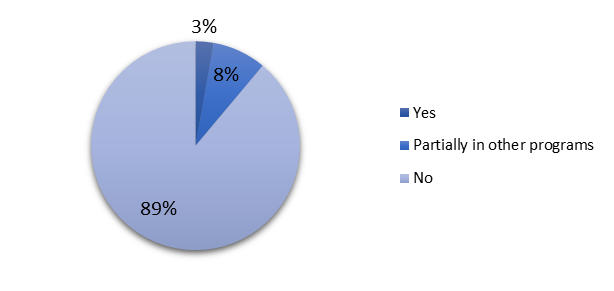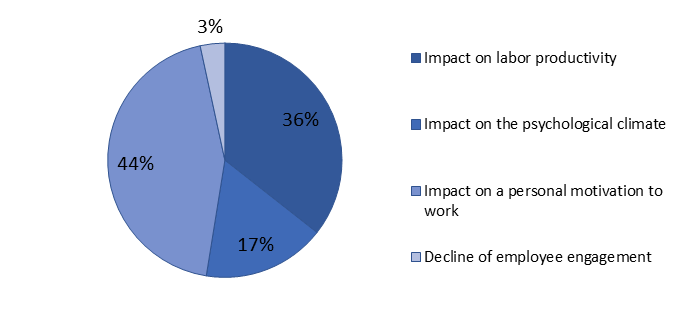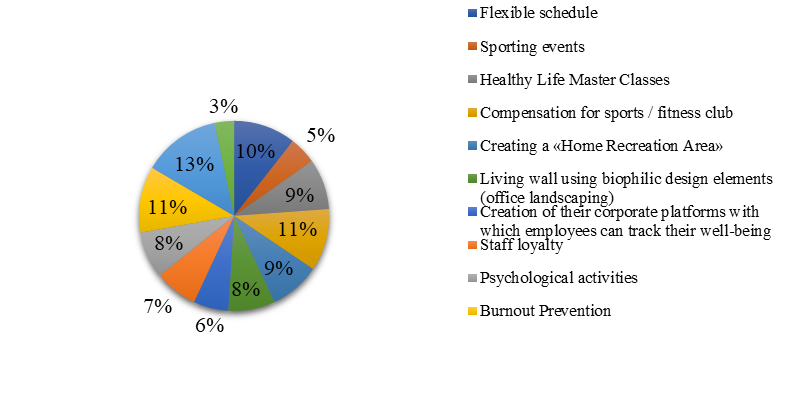Abstract
Having studied the main approaches that determine the requirements for personnel in the digital economy, it can be argued that, despite the dominance of DIGITAL and the need for the formation and development of nuclear solid personnel’ competencies (in such areas of cross-cutting digital technologies as neurotechnology and artificial intelligence; distributed registry systems; quantum technologies; new manufacturing technologies; industrial Internet; robotics and sensor components; wireless technologies; virtual and additional reality technology), a lot of attention is paid to the development of soft skills of the staff (the ability to learn quickly, a high degree of adaptation to the new, cognitive flexibility, the ability to work in a team, emotional competence, etc.). The article describes the requirements for personnel in the digital economy. The results of a study on the use of well-being technology as part of the humanization of the personnel’ labor activity of organizations in the digital economy are presented. The study examined the impact of physical, mental, production, non-production factors associated with the state of the individual on the work and employees. The results of the research presented in the article confirm the tasks facing the labor economy for the implementation of the goals in the framework of personnel’ health-saving technologies. The influence of the transition from health to an increase in labor productivity is considered. The study also confirmed the importance of implementing well-being technology to motivate a staff.
Keywords: Staff competencies in the digital economyhumanization of laborwell-beingtools for maintaining well-beingstaff motivation in well-being
Introduction
The digital economy reflects the transition from the third industrial revolution to the fourth. The third industrial revolution, sometimes called the digital revolution, refers to the changes that occurred at the end of the 20th century with the transition from analog electronic and mechanical devices to digital technology. The fourth industrial revolution is based on the digital revolution, but is considered to be a new era due to the speed of technological breakthroughs, the prevalence of coverage and the huge impact of new systems. The term “digital economy” was first introduced in 1995 by the founder of the Massachusetts Institute of Technology MIT, Nicholas Negroponte. Currently, this term has gained worldwide recognition. The statistics look convincing: in China, this market segment contributes 6.9% of GDP, in India and the USA - 5.4%, and in Russia already 3.7% (The World Bank, 2016).
Having studied the main approaches that determine the requirements for personnel in the digital economy, it can be argued that, despite the dominance of DIGITAL and the need for the formation and development of nuclear solid personnel’ competencies (in such areas of cross-cutting digital technologies as neurotechnology and artificial intelligence; distributed registry systems; quantum technologies; new manufacturing technologies; industrial Internet; robotics and sensor components; wireless technologies; virtual and additional reality technology), a lot of attention is paid to the development of soft skills of the staff (the ability to learn quickly, a high degree of adaptation to the new, cognitive flexibility, the ability to work in a team, emotional competence, etc.)
Currently, the problem of training for the digital economy is being actively investigated. The variability of ideas about the competencies of competitive personnel in the era of the digital economy in one way or another relates to hard skills and soft skills of staff. A lot of studies have been devoted to the formation of key competencies for enterprise workers (Mironova, Zaitseva, Larionova, Novikov, & Borissova, 2017). In our study, we considered staff skills – orthobiotic and well-being skills as very important, from our point of view. In our opinion, they are an integral part of staff soft skills in the digital economy (Chulanova, 2019).
Many scientists studied the phenomenon of “well-being”. There are a sufficient number of studies devoted to this problem (Rath & Harter, 2010). However, a unified classification of the components of well-being still does not exist. Noteworthy is the study in which the authors identify the following areas of life as elements of well-being: 1) professional well-being (career, calling, profession or work); 2) physical well-being (good health); 3) social well-being (the importance of the immediate environment and social relationships); 4) financial well-being (financial security, satisfaction with one’s standard of living); 5) well-being in the living environment (security, own contribution to the development of society). At the same time, the authors emphasize that success must be present in all five elements, since achievements in one of the areas cannot compensate for failure in the other. Some of these components are evaluated objectively, others - subjectively (based on self-esteem). Each element contributes to a higher level of well-being, but "well-being does not come down to any of the components." Making a choice in life, we strive to achieve the greatest success in each component (Rath & Harter, 2010).
Numerous studies are devoted to monitoring working conditions and their impact on the health of staff (Vinichenko, Kirillov, Frolova, Kaurova, & Makushkin, 2016), studying the conditions for the development of a favorable learning environment and labor protection in the context of harmonizing the social interaction of staff (Rogach, Frolova, Kirillov, Bondaletov, & Vinichenko, 2016), social partnership (Frolova, Medvedeva, Kabanova, Kurbakova, & Vinichenko, 2016), empathy in team work (Yudina, 2017). Noteworthy is the study of well-being conducted by Galiakhmetova (2015) in which she interconnects the triad: well-being, subjective well-being and life satisfaction, increasing staff loyalty by improving the system of motivation (incentive) at the enterprises of the oil and gas complex (Chulanova et al., 2018).
Problem Statement
Thus, it becomes clear that the research started at the beginning of the 20th century by Mechnikov (2011) and, continued in the 80-90s of the last century by Shepel, (1999) devoted to orthobiotics, preserving the health of staff within the framework of the humanization of work, is filled with new meanings in the era of the digital economy in a new direction of well-being. Today, the definition of employee health has expanded significantly, and includes a number of programs designed not only to protect the health of employees, but also to actively increase productivity, as well as social and emotional well-being. They currently include innovative programs and tools for staff financial well-being, staff mental health, healthy eating and exercise, mindfulness, sleep and stress management, as well as changes in culture and leadership behavior to support these efforts. The issues of choosing tools and methods of social, emotional, mental, physical, financial well-being of staff are acute.
“Deloitte” (an international network of consulting and audit services. “Deloitte” is one of the “Big Four” of audit companies and is the largest professional network by the number of employees (263,900 people). In 2017, magazine “Fortune” included “Deloitte” in the rating of 100 the most prominent companies in the world) held a discussion on the topic “Welfare” at the 2017 IMPACT conference and the participants agreed that “welfare is a workforce preparedness strategy”. In other words, if people do not appear at work, feeling rested, healthy and in a resource state, then organizations simply cannot work effectively. So, well-being technology has a direct connection with motivation. This simple idea is the foundation of a modern, prosperous welfare market.
According to Bersin (2018) today in the HR technology market there are dozens of tools, platforms, training programs and analytical systems designed to measure, monitor and improve well-being at work. Oracle, for example, has implemented a well-being solution built into the latest releases of the Oracle HCM cloud. Ceridian Dayforce HCM offers “TeamRelate” profiles to provide staff with personalized coaching on how to interact with other employees based on their personality and type of profile.
CIPD presented a survey of more than 1000 HR professionals in the eighteenth annual survey report . The study shows that the problem in the workplace related to mental health has clearly increased in recent years. The line between people's work and inner experiences is becoming increasingly blurred: many people find it impossible to leave their personal problems outside the office. This means that organizations need to be aware of the difficulties in the lives of employees and treat them with understanding, because some need support (CIPD, 2017).
The HR profession plays a key role in managing an organization’s health and well-being program by ensuring that managers see it as a priority and that employee well-being practices are integrated into the organization’s daily work.
Researchers and practitioners highlight the key areas that HR specialists should adhere to: studying the potential reasons for the absence of workers in the workplace; individual policies and practices for managers and employees; creating a more solid foundation for developing good mental health; make a compelling business proposition for investing in a healthy culture; strengthen the capabilities of line managers.
Most organizations provide the well-being of employees in such a way: 87% offer some kind of health promotion benefit (most often with free vision tests); more than three quarters offer some form of employee support (most often access to advisory services and employee assistance programs); 70% offer some kind of insurance or protection to at least some groups of personnel; CIPD results show that the proportion of organizations offering employee assistance programs, accident insurance, etc. increased compared to previous years; the proportion of organizations offering employee health screening remains at the same level (CIPD, 2017).
The study of the main causes of stress in work over the past few years is worth attention. Workload is the most common cause of stress, especially in large organizations. Management style is the second main cause of stress (Bratcher, 2018).
Research Questions
Previously, in the process of research we proposed the author's operationalization of soft skills with the inclusion of well-being and orthobiotic skills in the structure (Chulanova, 2018). Due to the insufficient knowledge of the use of well-being technology in the practice of working with the personnel of Russian organizations, taking into consideration the actuality of use of well-being technology not only in the processes of humanization of staff work, but also in motivation, there are several questions that need to be considered:
What factors are at the heart of the well-being, well-being of employees in Russian companies?
How does the well-being and well-being of employees affect the efficiency of business processes?
What tools can measure or monitor improvements in well-being at work?
What tools would you use in your organization to support staff well-being?
Purpose of the Study
The purpose of this study is to identify the main ways to maintain the well-being of staff on the part of the organization. To achieve this goal, we must solve the following problems: conduct a study and, using expert assessment, rank the importance of well-being tools that an organization can use to maintain the well-being of employees.
Research Methods
As part of the February-March 2019 study, a survey was conducted among the staff of organizations on the implementation of humanization technologies for work in the organizations in which they work (in particular, on the implementation of the Well-being technology). The survey involved 216 people from organizations of the Khanty-Mansiysky Autonomous Okrug-Ugra, Moscow, St. Petersburg, Novosibirsk. The survey was conducted online using Google Forms.
Findings
In the course of processing the research results, it turned out that the well-being technology is not implemented in many companies (89%) or partially implemented, as part of other programs (8%), mainly in large companies, and only 3% of companies implement this technology in full, mainly only in small and medium-sized businesses (Figure

The emotional state of an employee primarily affects his personal motivation to work (44%), also labor productivity (36%), the psychological climate inside the company (17%), and only 3% on a decrease in employee involvement (Figure

Respondents would like to maintain their well-being, to engage in self-preservation of health and well-being through: a good social package (13%); compensation for the cost of playing sports / visiting a fitness club (11%); burnout prevention (11%); flexible schedule (10%); master classes in healthy lifestyles (9%); creation of corporate platforms with which employees can track their well-being (9%); creation of comfortable working and resting conditions (13%); psychological activities (8%); staff loyalty (7%); sporting events (5%); psychological consultation with a specialist (3%) (Figure

Further study of the technology allowed us to consider possible digital well-being platforms. Maintenance of well-being by the employee himself is possible using the LifeAddWiser service, with which you can evaluate all areas of your life: health, finance, career, social well-being.
If you focus on practical examples of well-being, it is worth noting that organizations are now paying more and more attention to the well-being of employees. A recent study at SunTrust Bank convincingly showed that 70% of working adults experience moderate or high levels of financial stress in their lives. After that, the bank’s management introduced a free online training program that helps employees save $ 2 thousand in case of emergency, get one extra paid day off, draw up a will, form a family budget, etc. Companies also integrate the latest technology into health programs. Wellness programs use the Internet of Things (IoT) and integrate artificial intelligence into well-being solutions. AI tools allow users to find out the state of their health and the fitness program’s capabilities. One of the Russian airlines has already a practice of one-time awards “for a healthy lifestyle”. Thus, issues related to ensuring the well-being and welfare of employees will be actualized in the near future, including in the tasks of motivating staff work in the digital economy.
Conclusion
Integrating and developing the approaches of various researchers, we can single out the main advantages of implementing well-being technology: the formation of a positive image of the organization as an organization working on the humanization of the staff’s labor activity actively; increase motivation, flexibility and retention of staff; improving psychological well-being; increase in labor productivity; cost reduction for benefits; ensuring loyalty and involvement of the organization’s personnel.
Along with the advantages, the risks should be taken into account: high costs of implementation and ongoing maintenance; requires a serious attitude of the leader to technology; prolonged return on technology adoption; It takes time to introduce technology.
References
- Bersin, J. (2018). HR Technology Disruptions for 2018. Retrieved from: https://www.isaconnection.org/assets/documents/2018BersinHRTechDisruptionsReport.pdf Accessed: 08.11.2018.
- Bratcher, E. (2018). Trend micro’s Austin offices inspire collaboration and interaction, 2018. Retrieved from: https://workdesign.com/2018/02/trend-micros-austin-offices-inspire-collaboration-and-interaction/ Accessed: 09.03.2019.
- Chulanova, O. L. (2018). Challenges and trends in the labor market: Synergy of digitalization and soft skills. Human Resources and Intellectual Resources Management in Russia, 7(3), 66-72.
- Chulanova, O. L. (2019). Competence of staff in a digital economy: The operationalization of the soft skills of the organization’s staff with orthobiotic and well-being skills. The Eurasian Scientific Journal, 11(2). Retrieved from: https://esj.today/PDF/22ECVN219.pdf Accessed: 08.11.2018. (free access). [in Rus.].
- Chulanova, O. L., Ryngach, O. L., Vinichenko, M. V., Kaurova, O. V., Demchenko, M. V., & Demchenko, T. S. (2018). Increase of staff loyalty by improving the motivation (stimulation) system in enterprises oil and gas complex of the Khanty-Mansiy Autonomous District-Ugra. Modern Journal of Language Teaching Methods, 8(8), 39-47.
- CIPD (2017). Financial well-being: the employee view, 2017. Retrieved from: https://www.cipd.co.uk/Images/financial-well-being-employee-view-report_tcm18-17439.pdf Accessed: 08.11.2018.
- Frolova, E. V., Medvedeva, N. V., Kabanova, E. E., Kurbakova, S. N., & Vinichenko, M. V. (2016). Social partnership in Russia: Prerequisites, problems and trends. Journal of Advanced Research in Law and Economics, 7(2), 221-228.
- Galiakhmetova, L. I. (2015). Well-being, subjective well-being, life satisfaction: The problem of interconnection. Actual Problems of Psychological Knowledge, 2(35), 89-100. [in Rus.].
- Mechnikov, I. I. (2011). Sketches on the nature of man. Moscow: Knigovek. [in Rus.].
- Mironova, M. D., Zaitseva, N. A., Larionova, A. A., Novikov, A. I., & Borissova, A. A. (2017). The formation of key competencies of employees of the enterprises of service sphere, applying innovative management techniques. International Journal of Advanced Biotechnology and Research, 8(2), 660-666.
- Rath, T., & Harter, J. (2010). The economics of wellbeing. Washington: Gallup.
- Rogach, O. V., Frolova, E. V., Kirillov, A. V., Bondaletov, V. V., & Vinichenko, M. V. (2016). Development of favourable learnıng envıronment and labor protectıon ın the context of harmonızatıon of socıal interactıon of educatıonal system objects. IEJME – Mathematics Education, 11(7), 2547-2558.
- Shepel, V. M. (1999). The human history competence of the manager. Administrative Anthropology for managers. Moscow: Public Education. [in Rus.].
- The World Bank (2016). World Development Report 2016 Digital Dividends. Overview. Retrieved from: https://openknowledge.worldbank.org/bitstream/handle/10986/23347/210671RuSum.pdf Accessed: 23.10.2019. [in Rus.].
- Vinichenko, M. V., Kirillov, A. V., Frolova, E. V., Kaurova, O. V., & Makushkin, S. A. (2016). Monitoring of working conditions and the nature of their influence on health of students and academic staff. International Journal of Environmental and Science Education, 11(11), 4564-4577.
- Yudina, T. O. (2017). Empathy and moral: Meeting point (review of foreign research). Steps, 3(1), 28-39. [in Rus.].
Copyright information

This work is licensed under a Creative Commons Attribution-NonCommercial-NoDerivatives 4.0 International License.
About this article
Publication Date
09 March 2020
Article Doi
eBook ISBN
978-1-80296-078-5
Publisher
European Publisher
Volume
79
Print ISBN (optional)
-
Edition Number
1st Edition
Pages
1-1576
Subjects
Business, business ethics, social responsibility, innovation, ethical issues, scientific developments, technological developments
Cite this article as:
Сhulanova*, O. L., & Ryngach, O. L. (2020). Research Of Motivational Possibilities Of Well Being Technology In A Digital Economy. In S. I. Ashmarina, & V. V. Mantulenko (Eds.), Global Challenges and Prospects of the Modern Economic Development, vol 79. European Proceedings of Social and Behavioural Sciences (pp. 626-632). European Publisher. https://doi.org/10.15405/epsbs.2020.03.90
